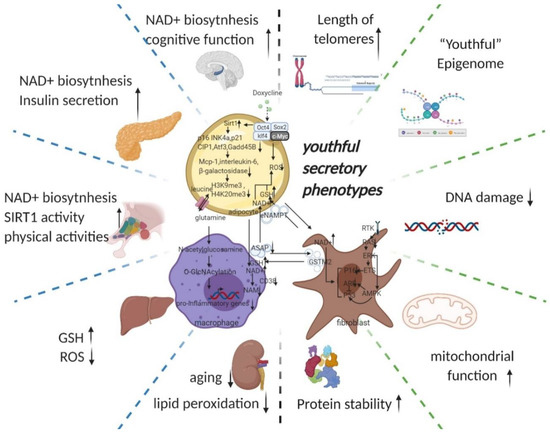 Forum für Lebensverlängerung
»
Radikale Lebensverlängerung, Sport, Verschiedenes
»
Radikale Lebensverlängerung
»
Senolysis Program-Brainstorming
Forum für Lebensverlängerung
»
Radikale Lebensverlängerung, Sport, Verschiedenes
»
Radikale Lebensverlängerung
»
Senolysis Program-Brainstorming


|
|
Aus 2020, frei zugänglich:
parcel, Roger und Prometheus haben sich bedankt!
|

|
|
Hallo allerseits,
Prometheus und mithut haben sich bedankt!
|

|
|
A genome-wide CRISPR-based screen identifies KAT7 as a driver of cellular senescence |

|
|
Senolytic combination of Dasatinib and Quercetin alleviates intestinal senescence and inflammation and modulates the gut microbiome in aged mice |

|
|
Step further towards targeted senolytic therapy: therapeutic potential of uPAR-CAR T cells for senescence-related diseases
CRONos sagt danke
|

|
|
Ja, Setralin wirkt senolytisch und als mTOR-Hemmer: |

|
|
Gibt es denn irgendwelche Untersuchungen wie sich Sertralin auf die Lebensspanne von Modellorganismen auswirkt? Aufgrund der mTOR Hemmung und der senolytischen Effekte eigentlich positiv denk ich mal, wenn da nicht der negative Einfluss von Serotonin wäre.
Prometheus sagt danke
|

|
lupor
(
gelöscht
)

|
Wie verhalten sich Senolytika denn in Hinblick auf den Herzmuskel? Bei zu langem Fasten gibt es ja kritische Stimmen, die Gefahren für das Herz sehen. Herzmuskelzellen können sich auch nur begrenzt teilen und regenerieren. Also mit starken Senolytika wäre ich glaube ich vorsichtig derzeit. |

|
|
https://medicalxpress.com/news/2021-12-n...vitamin-b2.html
Speedy, Tizian und Prometheus haben sich bedankt!
|

|
|
Senolytic Cocktail Dasatinib+Quercetin (D+Q) Does Not Enhance the Efficacy of Senescence-Inducing Chemotherapy in Liver Cancer |

|
|
Zitat Zitat von Speedy im Beitrag Klotho |

|
|
Zitat
|

|
|
Pan-mTOR inhibitors sensitize the senolytic activity of navitoclax via mTORC2 inhibition-mediated apoptotic signaling |

|
|
Fisetin+OPC+Quercetin+Langer Pfeffer für 3 Tage jeweils in High-dose so mache ich es derzeit alle 3-4 Monate mal. Verträglichkeit ist OK außer wenn ich es mit der Fisetin Menge übertreibe und folglich Grippe ähnliche Symptome auftreten. Bei Hochdosis Langer Pfeffer beachten es kann ein Hitzegefühl auftreten.
Roger, vera8555 und Prometheus haben sich bedankt!
|

|
|
Senolyse, von mir noch einmal neu gedacht.
parcel sagt danke
|

|
Gelöschtes Mitglied

|
#142 Der neue Thread ist schon geschlossen?
Prometheus sagt danke
|

|
|
|

|
Gelöschtes Mitglied

|
Mal hier rein, da es besser passt. Zitat von Methusalem im Beitrag Haustiere Keine Ahnung, habe vielleicht noch zu wenig von dir gelesen. Zitat von Dr.Faust im Beitrag Haustiere Wieso sollte man eher keinen Schlaganfall bekommen, wenn man nicht mit Hormonen arbeitet, als wenn man es tut? Wir reden nicht über Bodybuilder-Dosen. Das war aber auch nur ein Beispiel, ich nehme gerade keine Hormone. Zitat von Dr.Faust im Beitrag Haustiere Vielleicht bringt es ein bisschen was, aber über einen niedrigen bis mittleren zweistelligen Prozentbetrag der Lebensverlängerung wirst du damit auch nicht hinauskommen. Oder glaubst du, du bist der erste Mensch der das macht?  Zitat von Dr.Faust im Beitrag Haustiere Bei Longecity liest man viel Spannendes, hier haben z.B. einige User FOXO4-DRI ausprobiert: https://www.longecity.org/forum/topic/95...tide-group-buy/ Verrückt und potentiell lebensgefährlich? Bestimmt, aber es bringt die Menschheit voran und ist interessant zu verfolgen.  |

|
|
Das Forum guck ich mir mal an @version2
parcel und Prometheus haben sich bedankt!
|

|
Gelöschtes Mitglied

|
So wie ich das sehe, wurden in der berühmten FOXO4-DRI Studie folgende Dosen verabreicht: Zitat
Prometheus sagt danke
|

 Thema drucken
Thema drucken 19.12.2020 20:18
19.12.2020 20:18

 Antworten
Antworten


 Vor allem wenn die Theorie stimmt, dass seneszente Zellen nicht unbedingt nur Ursache, sondern auch Symptom von Problemen sind. Den anekdotischen Berichten von Selbstexperimentatoren nach fühlten sich einige nach der Injektion besser, aber das verging dann nach ein paar Wochen wieder.
Vor allem wenn die Theorie stimmt, dass seneszente Zellen nicht unbedingt nur Ursache, sondern auch Symptom von Problemen sind. Den anekdotischen Berichten von Selbstexperimentatoren nach fühlten sich einige nach der Injektion besser, aber das verging dann nach ein paar Wochen wieder.